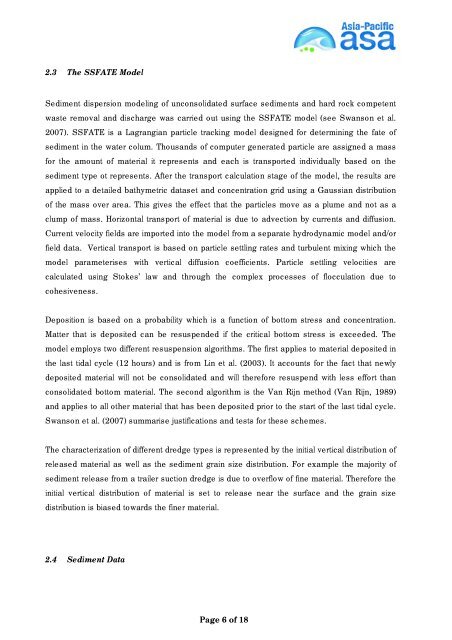Appendices 5-13 - Nautilus Cares - Nautilus Minerals
Appendices 5-13 - Nautilus Cares - Nautilus Minerals
Appendices 5-13 - Nautilus Cares - Nautilus Minerals
You also want an ePaper? Increase the reach of your titles
YUMPU automatically turns print PDFs into web optimized ePapers that Google loves.
2.3 The SSFATE Model<br />
Sediment dispersion modeling of unconsolidated surface sediments and hard rock competent<br />
waste removal and discharge was carried out using the SSFATE model (see Swanson et al.<br />
2007). SSFATE is a Lagrangian particle tracking model designed for determining the fate of<br />
sediment in the water colum. Thousands of computer generated particle are assigned a mass<br />
for the amount of material it represents and each is transported individually based on the<br />
sediment type ot represents. After the transport calculation stage of the model, the results are<br />
applied to a detailed bathymetric dataset and concentration grid using a Gaussian distribution<br />
of the mass over area. This gives the effect that the particles move as a plume and not as a<br />
clump of mass. Horizontal transport of material is due to advection by currents and diffusion.<br />
Current velocity fields are imported into the model from a separate hydrodynamic model and/or<br />
field data. Vertical transport is based on particle settling rates and turbulent mixing which the<br />
model parameterises with vertical diffusion coefficients. Particle settling velocities are<br />
calculated using Stokes’ law and through the complex processes of flocculation due to<br />
cohesiveness.<br />
Deposition is based on a probability which is a function of bottom stress and concentration.<br />
Matter that is deposited can be resuspended if the critical bottom stress is exceeded. The<br />
model employs two different resuspension algorithms. The first applies to material deposited in<br />
the last tidal cycle (12 hours) and is from Lin et al. (2003). It accounts for the fact that newly<br />
deposited material will not be consolidated and will therefore resuspend with less effort than<br />
consolidated bottom material. The second algorithm is the Van Rijn method (Van Rijn, 1989)<br />
and applies to all other material that has been deposited prior to the start of the last tidal cycle.<br />
Swanson et al. (2007) summarise justifications and tests for these schemes.<br />
The characterization of different dredge types is represented by the initial vertical distribution of<br />
released material as well as the sediment grain size distribution. For example the majority of<br />
sediment release from a trailer suction dredge is due to overflow of fine material. Therefore the<br />
initial vertical distribution of material is set to release near the surface and the grain size<br />
distribution is biased towards the finer material.<br />
2.4 Sediment Data<br />
Page 6 of 18


